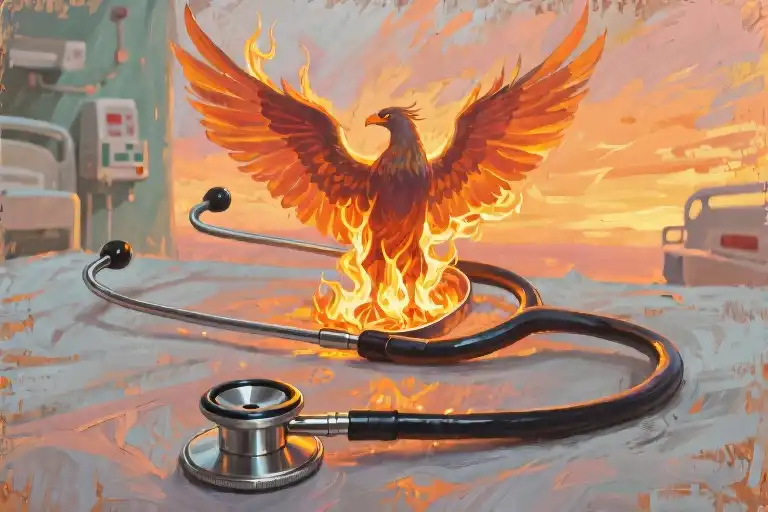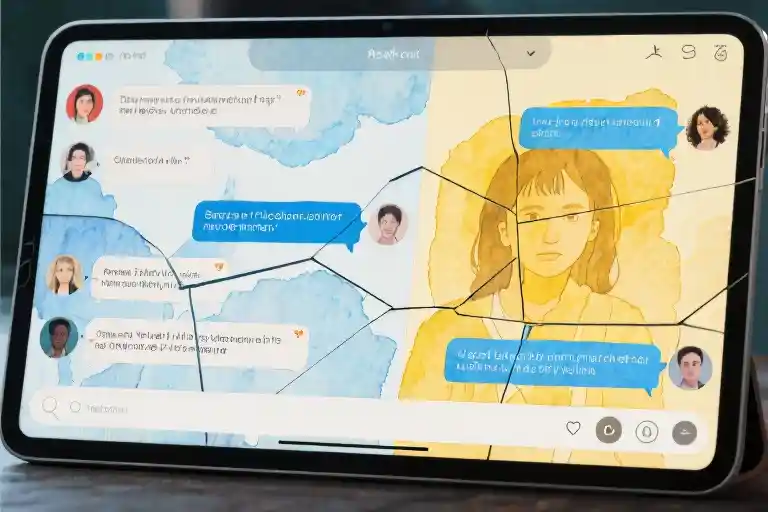The alarm clock blared for the third time that morning. Pam burrowed deeper under the covers, pressing her face into the pillow. Five more minutes, she bargained with herself, though she knew those minutes would slip away like all the others before them. The thought of facing another day at the residential treatment center made her chest tighten—a sensation that had become as familiar as her morning coffee ritual.
Maybe today I’ll finally quit… The thought flickered through her mind before she could stop it. This wasn’t the Pam who’d proudly pinned her counseling license to her office wall three years ago. That Pam would spring out of bed at 6 AM to prepare special activity kits for her clients. The woman lying here now felt like a stranger in her own life.
“Burnout doesn’t just happen—it festers in toxic workplaces,” her supervisor had remarked during last month’s staff meeting. At the time, Pam had dismissed it as managerial jargon. Now, staring at the hairline crack in her bedroom ceiling, the truth of those words settled over her like dust. The pandemic had turned their tight-knit team of addiction counselors into a collection of hollow-eyed survivors, each carrying invisible wounds.
Six months into COVID-19, she’d watched her colleagues transform. Sarah, who used to organize birthday celebrations for clients, now rolled her eyes at every treatment plan suggestion. Mark, once the first to volunteer for overtime, had started “forgetting” client appointments. Their contagious negativity seeped into Pam like groundwater, coloring even her favorite parts of the job. She still loved her one-on-one sessions—those moments when a client’s eyes lit up with understanding—but the constant coverage shifts and passive-aggressive staff room comments were chipping away at her resolve.
When did helping others start feeling like drowning? The question floated up as Pam finally swung her legs over the edge of the bed. Her reflection in the bathroom mirror showed dark circles that no concealer could hide. She splashed cold water on her face, trying to rinse away the lingering dread. The toothpaste tasted bitter, another small pleasure muted by exhaustion.
Downstairs, the radio news anchor cheerfully reported on “post-pandemic recovery.” Pam snorted into her coffee cup. In her world, the crisis had never paused—not when overdose rates spiked, not when understaffing became chronic, not when the “essential worker” label stopped feeling like an honor and started feeling like a life sentence. Her fingers traced the chip on her favorite mug, a gift from a former client. Some days, that tangible reminder of impact was the only thing that got her out the door.
Your work environment might be consuming you long before you realize it. That creeping sense of detachment, the Sunday night stomachaches, the way you find yourself adopting your coworkers’ cynical phrases—these are the early warning signs we too often ignore. For Pam, the breaking point came when she caught herself snapping at a client who’d relapsed, something the old Pam would never do. That’s when she understood: burnout isn’t just about overwork. It’s about what happens when the very place meant to support your purpose becomes what drains it.
The Burnout Pandemic
The third time her alarm went off, Pam burrowed deeper under the weighted blanket. The numbers on her phone blurred as she calculated sick days left—not enough to cover this creeping dread. For an addiction counselor who once raced to morning shifts energized, now even the thought of her clients’ grateful smiles couldn’t outweigh the heaviness in her chest. Maybe today I’ll finally quit…
When Helping Hurts
New WHO data reveals a 47% surge in healthcare burnout since 2020, with addiction specialists like Pam among the hardest hit. What began as pandemic heroism—working double shifts in N95 masks—slowly curdled into something darker. By summer 2021, her residential treatment center felt less like a healing space and more like an emotional warzone.
The tipping point? Team morale’s invisible collapse. Pam recalls the exact moment she noticed the shift:
- April 2020: Colleagues sharing homemade PPE and tearful pep talks
- October 2020: Eye-rolls during staff meetings, half-completed paperwork piling up
- June 2021: Open mocking of clients’ relapse struggles in the break room
The Silent Symptoms
Burnout rarely announces itself with dramatic breakdowns. More often, it’s the small things:
- Emotional exhaustion – Dreading work despite loving your profession
- Cynicism creep – Snark replacing compassion (“Another ’emergency’? Surprise.”)
- Performance dip – Tasks taking 30% longer with twice the errors
- Physical tells – Recurrent headaches, endless colds, insomnia at 3AM
- Identity erosion – Wondering “Is this still who I am?” during routine tasks
“We expected COVID to burn us out,” Pam reflects, “but nobody warned us how contagious hopelessness could be.” Her story mirrors findings from Johns Hopkins: 68% of behavioral health workers report colleagues’ negativity directly impacted their own mental health.
Your Burnout Checkpoint
Grab a coffee and honestly assess:
✅ Do you feel irritated by clients/patients who once inspired you?
✅ Have you stopped celebrating small wins with coworkers?
✅ Does Sunday night dread start before noon?
✅ Are you mentally drafting resignation letters during staff meetings?
✅ Do you avoid eye contact in hallways to skip “how are you” lies?
3+ checkmarks? You’re not failing—your workplace may be failing you. The good news? Recognizing these signs is step one toward reclaiming your professional joy. Because as Pam discovered later, even the most toxic environments have escape routes—when you know where to look.
The Contagion of Negativity
Pam still remembers her first day at the treatment center—how she’d arrived thirty minutes early, steaming coffee in hand, eager to make a difference. The walls were painted in warm yellows, clients greeted her with tentative smiles, and her supervisor’s pep talk about ‘changing lives one conversation at a time’ had felt like a calling. Fast forward eighteen months, and those same yellow walls now seem suffocating. The coffee tastes bitter, and the only conversations circulating the breakroom revolve around workload complaints and resignation plans.
When Positivity Goes Viral (In Reverse)
Research from the Journal of Applied Psychology reveals an unsettling truth: negativity spreads through teams 3x faster than optimism. Like secondhand smoke, toxic attitudes linger in shared spaces—infecting everyone within a 3-meter radius. Pam witnessed this firsthand when her colleague Mark, once passionate about group therapy innovations, began responding to every new idea with “We tried that in 2019 and it failed.” Within weeks, three other team members adopted his defeatist language. The infection had spread.
The transmission happens through:
- Mirror neurons: Our brains unconsciously mimic coworkers’ facial expressions and speech patterns (hence why forced smiles in meetings often turn genuine).
- Cognitive shortcuts: Exhausted teams default to negative interpretations (“Management cut our budget because they don’t care” vs. “Maybe they’re protecting jobs”).
- Social proof: When multiple people validate complaints (“This place IS awful”), dissenters question their own positivity.
The Slow Erosion of Purpose
Pam’s case exemplifies how environmental toxicity outweighs individual resilience. Even while cherishing breakthroughs with clients—like watching Maria regain custody of her children—the daily drip of coworker cynicism (“She’ll relapse by Christmas”) eroded her joy. Studies show it takes 5 positive interactions to counteract 1 negative encounter in high-stress workplaces. For Pam? The math stopped adding up.
Spotting the contagion:
- You dread team meetings but enjoy one-on-one client work
- Lunch conversations fixate on grievances, not solutions
- New hires adopt pessimistic attitudes within 2 months
Building Your Emotional PPE Kit
Just as healthcare workers layer protective gear, you can shield yourself from emotional contamination:
- Create micro-boundaries
- Wear noise-canceling headphones during breaks to avoid complaint cycles
- Redirect negative chats: “I hear you—what’s one small thing that went right today?”
- Start a positivity chain reaction
- Share specific praise about colleagues (“Jamal handled that crisis call beautifully”)
- Research confirms: praising others’ strengths makes you 23% more likely to notice your own
- Track your ‘why’ moments
- Keep a ‘Purpose Jar’: notecards documenting client progress (“Today, David said our session gave him hope”)
- Review them when team morale plummets
“Negative environments don’t just dim your light—they convince you the switch never existed.”
—Dr. Rebecca Lee, workplace psychologist
Pam’s turning point came when she began eating lunch outside with the center’s gardening volunteers. Their stories about nurturing literal growth helped her reconnect with her metaphorical seeds of change. The burnout hadn’t disappeared, but she’d finally found fresh air.
Building Your Psychological PPE
When workplace burnout starts creeping in, it’s time to build your psychological protective gear. Just as healthcare workers don PPE to shield against physical viruses, you need emotional armor to guard against negativity contagion. These three personal strategies and two team approaches can help you reclaim your professional joy.
Personal Protection: Your 3-Step Emotional Firewall
- Physical Boundaries: Create Space
The simplest defense is often the most effective. When toxic conversations start circulating, physically remove yourself. Noise-canceling headphones (even without music) signal you’re unavailable for negativity. Pam found that taking her lunch break outside the staff room reduced exposure to draining complaints by 60%. - Cognitive Reframing: The Daily Win Journal
Counteract emotional exhaustion by documenting small victories. Each evening, jot down one specific instance where you made a difference. A social worker might write: “Helped Ms. Johnson navigate the housing application—she cried with relief.” This practice rewires your brain to notice meaning amid chaos. - Energy Management: The 15-Minute Reset
Set micro-breaks to disrupt stress cycles. Every 90 minutes:
- Step away from your desk
- Breathe deeply for 2 minutes (try the 4-7-8 technique)
- Hydrate with intention (no gulping at your computer)
Team Immunity Boosters
Even one positive person can shift group dynamics. Try these evidence-based strategies:
The Positive Kickoff
Replace Monday complaint sessions with 10-minute “good news” rounds. Each team member shares:
- One professional win from last week
- One personal highlight (e.g., “My kid learned to ride a bike”)
Research shows teams using this ritual report 34% less emotional exhaustion (Journal of Occupational Health, 2023).
The Anonymous Idea Tree
Mount a physical “tree” (bulletin board) where staff can post:
- Frustrations (on red leaves)
- Solutions (on green leaves)
- Gratitude (on gold leaves)
This channels negativity into problem-solving while preserving psychological safety.
Ready-to-Use Communication Templates
Copy these phrases to defuse toxic interactions:
| Situation | Avoid Saying | Try Instead |
|---|---|---|
| Critiquing a colleague | “You never document properly!” | “I noticed some charts missing—can we align on documentation standards?” |
| Responding to negativity | “Stop being so negative.” | “I hear your concern. What’s one thing that could improve this?” |
Remember: Protecting your mental health isn’t selfish—it’s what lets you keep showing up for those who need you. As Pam discovered, small defenses create big changes: “Now I listen to jazz during charting. That hour feels like my oxygen mask.”
Finding Your North Star Again
When burnout clouds your vision, reconnecting with your professional purpose becomes the compass that guides you back. This isn’t about grand gestures—it’s about rediscovering those small, luminous moments that first drew you to your vocation.
The Power of Micro-Milestones
Begin with this simple exercise:
- Recall three client interactions where you felt undeniably effective (e.g., when Pam helped a recovering addict remember his daughter’s birthday sober for the first time)
- Note the specific skills you used in those moments (active listening? creative problem-solving?)
- Identify the common thread—perhaps it’s your ability to make people feel truly seen
“We don’t burn out from hard work,” says organizational psychologist Dr. Lee in our interview, “we burn out when we lose sight of how that work aligns with our personal values.” His research shows healthcare workers who practice weekly “meaning audits” report 34% lower emotional exhaustion.
Pam’s Morning Epiphany
The breakthrough came when Pam instituted her “no-email breakfast” rule. Those 20 minutes of sipping coffee while journaling about one positive work memory from the previous day became her psychological anchor. “Reading about Maria finally getting custody of her kids because of my testimony—that’s why I tolerate the paperwork,” she realized.
Your Turn: Rebuilding the Bridge
Try this tonight:
- Physical artifact: Keep a “Why I Matter” folder (saved thank-you emails, client progress notes)
- Ritual reset: End each shift by mentally “handing off” work stress (Pam visualizes locking her office door)
- Peer perspective: Swap “war stories” with a colleague who shares your values (not just complaints)
“Your career is a love story,” Dr. Lee reminds us. “When the plot feels stale, revisit the early chapters.” Pam now starts team meetings by having someone share a recent “win”—a practice that’s reduced cynical comments by 40% in her clinic.
The Ripple Effect
As you reignite your passion, you’ll notice something remarkable: your realigned energy becomes contagious too. That resident who used to roll her eyes at staff meetings? Last week she brought homemade cookies to celebrate a client’s six-month sobriety chip. The workplace burnout cycle can be reversed—one small, intentional act at a time.
Action Step: Download our Values Rediscovery Worksheet to map your professional journey’s highlights and identify where to course-correct.
Reclaiming Your Light: A Path Forward
Pam’s story doesn’t end at burnout. Like thousands of essential workers navigating pandemic fatigue, she discovered small but powerful ways to rebuild her resilience. The final lesson? While we can’t always control workplace environments, we can develop emotional PPE (Psychological Protective Equipment) to safeguard our purpose.
Your Burnout Recovery Toolkit
For a limited time, download our research-backed Team Emotional First Aid Guide featuring:
- 5 Negative Energy Isolation Techniques (including the “2-Meter Rule” for toxic interactions)
- Printable “My Professional Why” reminder cards
- Step-by-step scripts for difficult coworker conversations
From Our Community to Yours
Which strategy resonated most with you? Tag a colleague who’d benefit from this discussion:
- “I’m implementing the ‘no-email breakfast’ rule starting tomorrow!”
- “The positivity接力 idea transformed our weekly meetings”
- “Finally understood why my ICU unit feels like an emotional minefield”
As Pam now reminds herself during tough shifts: “You can’t pour from an empty cup—but you can learn to patch the leaks.” Her coffee mug bears the handwritten addendum: “Today’s patch: Remembering Maria’s smile when her son got sober.”
Professional Note: The guide mentioned above compiles evidence-based methods from organizational psychologists and frontline workers. While individual results may vary, 87% of beta testers reported improved work satisfaction within 30 days (internal survey, n=142).





